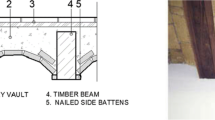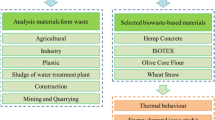Abstract
Purpose
Wooden boatyard building was replaced in the 1970s in favor of materials which are considered cheaper and simpler to work with (such as composite or aluminum). With today’s new environmental standards, the choices of materials must also be compatible with the aims of ecodesign. We promote wood-based boats and the replacement of exotic woods with local varieties (from France). An environmental impact assessment is needed to clarify the relative position of each solution.
Methods
In order to validate the choices, we used a life cycle assessment (LCA) “from cradle to grave” of the hull. This LCA is based on the comparison of the following different materials used: aluminum, composite, exotic wood, and maritime pine. This study is based on the construction of an 18-m-long passenger transport boat. These evaluations were carried out with respect to ISO 14040 standards, beginning with an existing database and measurements taken on the building and production sites.
Results and discussion
Our results demonstrate the benefits of using a wood-based hull compared with other materials. Moreover, the results show that the maritime pine used in replacement of imported exotic woods is more favorable from both economic and environmental points of view. This LCA allowed us to characterize precisely the stages in the life cycle of a passenger boat and to propose a hierarchy of the different materials under comparison for the purposes of boat building.
Conclusions
The recommendations and lines of progress highlighted by this study will allow us to enhance the efficiency of upcoming constructions and to promote the ecodesign conception in the boatyard.





Similar content being viewed by others
Notes
Chantier Naval Dubourdieu 1800, Port de Larros, 33470 Gujan-Mestras, France
References
Bertram C, Rehdanz K (2013) On the environmental effectiveness of the EU Marine Strategy Framework Directive. Mar Policy 38:25–40
Bureau Veritas (2012) Stresses and safety coefficient. Part B, Ch 7, Sec 4, pp 159–160
Cabezas-Basurko O, Mesbahi E, Moloney SR (2008) Methodology for sustainability analysis of ships (review). Ships Offshore Struct J 3(1):1–11
Champion J-B, Houlou-Garcia A, Lesdos-Cauhapé C, Quénechdu V (2013) En 2012, 90 % des déchets industriels triés sont valorisés. INSEE National Institute of statistics and economic studies, http://www.insee.fr/fr/themes/document.asp?ref_id=ip1535
COBAS (2010) Call for Greenboat program. http://www.agglo-cobas.fr/images/upload/bateau_propre_appel_a_projet.pdf. South Arcachon Bassin Community
Curran MA (2012) Life cycle assessment handbook: a guide for environmentally sustainable products. ISBN: 978-1-118-09972-8. Wiley, 640 pp
D’Aboville G (2009) Boating and environment. Part 2. Environmental impact of boat life cycle. Ministry of ecology. CSNPSN Council of sport and recreational boating. 72 pp
EcoNav network (2011) Second life for boats. Internal report University Bretagne Sud
EcoNav network (2012) Environmental impact analysis of pleasure boat. Internal report University Bretagne Sud
European Commission (2010) ILCD handbook: general guide on LCA—detailed guidance, Jt Res. 417. doi: 10.2788/38479
Foundation APER (2012a) Datas of boat deconstruction. Internal report. APER Environmental association for the boating sector
Foundation APER (2012b) Maps of authorised deconstruction society 48 sites in France. Internal report. APER Environmental association for the boating sector
Goedkoop MJ, Heijungs R, Huijbregts M, De Schryver A. Struijs J, Van Zelm R (2009) ReCiPe 2008, A life cycle impact assessment method which comprises harmonised category indicators at the midpoint and the endpoint level; First edition Report I: Characterisation; 6 January 2009, http://www.lcia-recipe.net
Grimaud G, Pommier R, Perry N (2013) Rapport LCA of different material to made boat hull. Internal report Project ABOVE + 2. University of Bordeaux
INSEE (2009) E11 shipbuilding industry in France. National Institute of statistics and economic studies.
IPCC (2014) Climate change 2014: impacts, adaptation, and vulnerability Chapter 8: transport. Work Gr III. Inter governmental panel on climate change Berlin, p 117
ISO (2006) ISO 14040: life cycle assessment—principles and framework. Environ Manag 3:28. doi:10.1002/jtr
Jacob A (2012) Composite boat building trends. Reinf Plast 56:3
Lavalette A, Pommier R, Danis M, Castéra P (2012) Tension-shear (TS) failure criterion for wood composite designed for shipbuilding applications. World Conf Timber Eng Sessin 11:8
Levrel H, Jacob C, Bailly D et al (2014) The maintenance costs of marine natural capital: a case study from the initial assessment of the Marine Strategy Framework Directive in France. Mar Policy 49:37–47
Maritime International Organisation (2005) MARPOL 73/78 Annex VI : regulations for the prevention of air pollution from ships. Internal report Maritime International Organisation
Marsh G (2006) 50 years of reinforced plastic boats. Reinf Plast 50:16–19
Mcleod E (2013) Marine protected areas: static boundaries in a changing world. Encycl Biodivers 94–104
Ministry of Ecology (2012) Environmental code—Natura 2000 places. Ministry of Ecology
Ministry of Ecology (2013) Pleasur boat marquet. Department of infrastructure and transport and sea
Ministry of Housing Spacial Planning and the Environment (2009) ReCiPe 2008 (first edition)—report I: characterisation. Ministry of Ecology
Pensec LLE, Pinon H (2007) Age and life duration of boats. http://www.dirm-memn.developpement-durable.gouv.fr/IMG/pdf/fiche8_AML-2.pdf. Ministry of ecology
Pommier R, Elbez G (2006) Finger-jointing green softwood: evaluation of the interaction between polyurethane adhesive and wood. Wood Mater Sci Eng 1:127–137
Princaud M (2011) Development of an environmental decision support tool based on life cycle analysis integrated into a design process. PhD. Arts et Métiers ParisTech
Princaud M, Cornier A, Froelich D (2010) Developing a tool for environmental impact assessment and eco-design for ships. HYPERLINK "http://www.researchgate.net/journal/1475-0902_Proceedings_of_the_Institution_of_Mechanical_Engineers_Part_M_Journal_of_Engineering_for_the_Maritime_Environment". Proceedings of the Institution of Mechanical Engineers Part M. J Eng Marit Environ 224 (3):207–224
Ridley IG, Hutchinson KW (2012) The efficacy and acceptance of environmental impact and life cycle models within the design sector of the marine industry. International Conference on the Environmentally Friendly Ship; London; United Kingdom; 28–29 February 2012; pp 45–55. Code 91686
Roussel F (2012) Dossier : L’aluminium recyclé, un taux d’incorporation qui stagne à 30%. Actu-environnement.com 10:3
Stoyell JL, Norman P, Howarth CR, Vaughan R (1999) Results of a questionnaire investigation on the management of environmental issues during conceptual design. A case study of two large made-to-order companies. J Clean Prod 7(6):457–464
Tukker DA (2002) Handbook on life cycle assessment: operational guide to the ISO standards. Volume 7. TNO Institute of Strategy, Technology and Policy
Van der Zee SC, Dijkema MB, van der Laan J, Hoek G (2012) The impact of inland ships and recreational boats on measured NOx and ultrafine particle concentrations along the waterways. Atmos Environ 55:368–376
Acknowledgments
The authors extend their warmest thanks to the Cluster ABOVE who financed the research and in particular to the Dubourdieu 1800 boatyard (Mr Emmanuel Martin) who built the Greenboat and who supplied us with a great quantity of data for our LCA.
Author information
Authors and Affiliations
Corresponding author
Additional information
Responsible editor: Holger Wallbaum
Rights and permissions
About this article
Cite this article
Pommier, R., Grimaud, G., Prinçaud, M. et al. Comparative environmental life cycle assessment of materials in wooden boat ecodesign. Int J Life Cycle Assess 21, 265–275 (2016). https://doi.org/10.1007/s11367-015-1009-1
Received:
Accepted:
Published:
Issue Date:
DOI: https://doi.org/10.1007/s11367-015-1009-1




